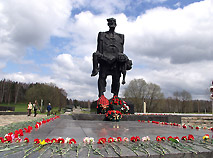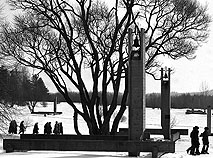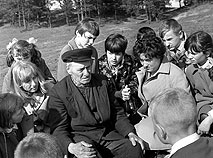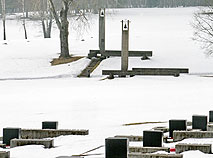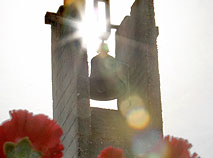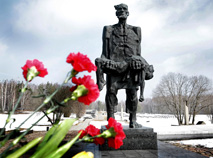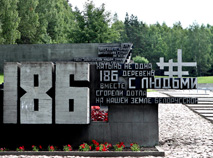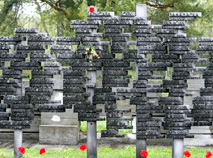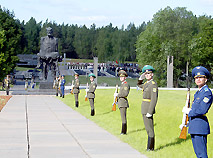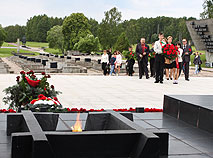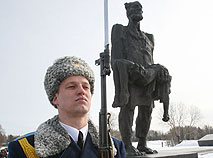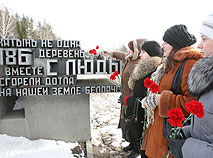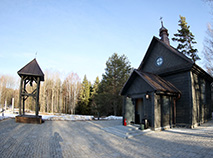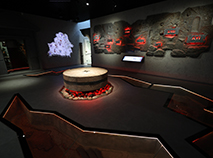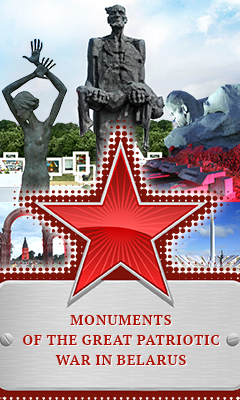Khatyn Memorial
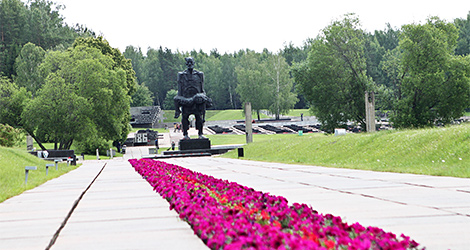
Khatyn Memorial. The Minsk region
The Khatyn Memorial Complex is a tribute to the memory of all those who died during the Great Patriotic War and a symbol of the unceasing pain of the Belarusian people, a tragic reminder of atrocities committed by the Nazis on this land. It is one of the most impressive memorials of World War 2 in entire Europe.
History of Khatyn
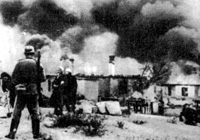
Until 1943, Khatyn was an ordinary Belarusian village located to the northeast of Minsk. On 22 March 1943, partisans ambushed a German convoy 6km away from the village killing a German officer. After that punitive brigades descended on Khatyn and encircled it. All the inhabitants, mostly women, children and the elderly, were rounded up and taken to a barn, which was then set on fire. 149 people, including 75 children, died.
Only one adult, 56-year-old Iosif Kaminsky, managed to escape from the barn. He tried to get his wounded son out of the barn, but could not save him. Only seven young residents of Khatyn miraculously survived, but not all of them lived to see the Victory.
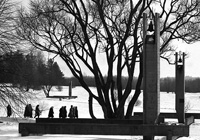 In 1969, the Khatyn Memorial Complex was unveiled on the site of the burned village to commemorate all Belarusians who died during the war. It became one of the world’s most recognizable symbols of numerous victims, suffering and courage of the Belarusian people during the Great Patriotic War. This is one of the most revered places in Belarus.
In 1969, the Khatyn Memorial Complex was unveiled on the site of the burned village to commemorate all Belarusians who died during the war. It became one of the world’s most recognizable symbols of numerous victims, suffering and courage of the Belarusian people during the Great Patriotic War. This is one of the most revered places in Belarus.
Khatyn’s story is not unique. During World War II over 650 Belarusian villages were burned together with their inhabitants. For many decades it was believed that 186 of the burned villages were never restored: this tragic figure is imprinted in a stone sign at the entrance to the world’s only Cemetery of Villages in the Khatyn Memorial Complex. However, the investigation into the criminal case on the genocide of the Belarusian people (initiated in April 2021), revealed that their number is 216.
The Khatyn Memorial Complex is a tribute to the memory of about three million Belarusians who died during the Great Patriotic War. The complex is located 54 km northeast of Minsk in Logoisk District, Minsk Oblast.
Khatyn today
The memorial complex reproduces the layout of the former village.
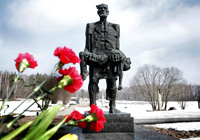 An impressive 6m bronze statue called “The Unconquered Man” stands in the center of the complex. The image of a man holding a dead boy in his arms is a tribute to Iosif Kaminsky and his son Adam.
An impressive 6m bronze statue called “The Unconquered Man” stands in the center of the complex. The image of a man holding a dead boy in his arms is a tribute to Iosif Kaminsky and his son Adam.
A black plate resembling a roof marks the location of the barn where Khatyn residents were burned alive. There is a mass grave nearby with a symbolic wreath of memory containing a message from the dead to the living.
There are 26 log houses in the place of the burned huts, with obelisks in the form of chimneys and bells inside. Bells ring every hour. Each obelisk lists the names of the people who lived in the burned houses.
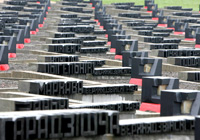 The Cemetery of Villages stands behind the houses. The symbolic cemetery contains soil brought from 185 burned villages that were never restored.
The Cemetery of Villages stands behind the houses. The symbolic cemetery contains soil brought from 185 burned villages that were never restored.
Next to it is the Wall of Sorrow. This is a reinforced concrete block with niches containing memorial plates with the names of over 260 death camps and places of mass extermination.
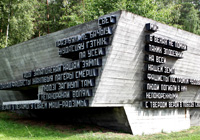 In the Square of Memory you will see three birches symbolizing life and the Eternal Flame symbolizing the inhabitants of Belarus who died during the war. Nearby is the Tree of Life listing 433 villages burned by the occupiers and restored after the war.
In the Square of Memory you will see three birches symbolizing life and the Eternal Flame symbolizing the inhabitants of Belarus who died during the war. Nearby is the Tree of Life listing 433 villages burned by the occupiers and restored after the war.
In 2022-2023, a large-scale renovation effort was carried out at the Khatyn Memorial Complex in the run-up to the 80th anniversary of the tragedy. Designers added new symbolic objects to the memorial complex during the renovation.
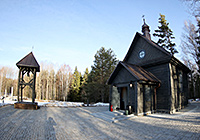 The wooden church of the Nativity of the Blessed Virgin Mary, consecrated on 18 March 2023, is a replica of the church that once stood in Khatyn. The documents that describe the 18th-century church are kept in the National Historical Archive of Belarus.
The wooden church of the Nativity of the Blessed Virgin Mary, consecrated on 18 March 2023, is a replica of the church that once stood in Khatyn. The documents that describe the 18th-century church are kept in the National Historical Archive of Belarus.
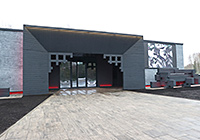 The Museum of Memory of the Belarusian People has recently opened at the entrance to the memorial complex. The museum is designed to show every visitor how terrible any aggression is, how much horror and destruction it brings, and how it turns people’s lives into ashes.
The Museum of Memory of the Belarusian People has recently opened at the entrance to the memorial complex. The museum is designed to show every visitor how terrible any aggression is, how much horror and destruction it brings, and how it turns people’s lives into ashes.
The one-storey museum features six halls that tell the story of major military conflicts and the tragedy of civilians. The exhibition is arranged circle-wise:
-
The Tree of History (military campaigns and wars on the Belarusian land in the 10th-20th centuries);
-
The Outbreak of the War;
-
Under Occupation (ghettos, the Holocaust, concentration camps, mass shootings of civilians - unique photographic evidence of the genocide of the Belarusian people);
-
Burned Villages;
-
Memory (a place of worship for all civilian victims of Belarus; includes names of all settlements, burned and not included in the Khatyn Memorial Complex and also those revived after the war);
-
Come and See (includes historical research on the tragedy of the war, reflects the history of the creation of the memorial complex).
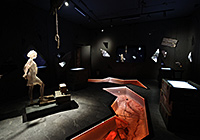 The central element of the exhibition is a ‘bloody stream’ symbolizing all the victims of aggression on the territory of Belarus. In the Under Occupation hall there is a touching sculpture of a girl walking to the scaffold as an embodiment of the innocently murdered people, a symbol of the youth that died before it had time to blossom.
The central element of the exhibition is a ‘bloody stream’ symbolizing all the victims of aggression on the territory of Belarus. In the Under Occupation hall there is a touching sculpture of a girl walking to the scaffold as an embodiment of the innocently murdered people, a symbol of the youth that died before it had time to blossom.
On the burned wall that reminds us of that terrible day of 22 March 1943 there is a map of Belarus that depicts smoldering embers that show 216 villages that shared the fate of Khatyn.
Getting to Khatyn and where to stay
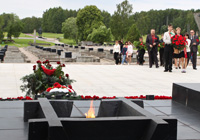 Khatyn can only really be reached by road.
Khatyn can only really be reached by road.
From Minsk, you take the M3 motorway towards Vitebsk. After 54km, there is a right turn to Khatyn, and the memorial is about 5km along this road.
If you’re planning a trip, it’s best to stay in one of the many Minsk hotels. Some of the larger hotels arrange daytrips to the Khatyn memorial.
Tourist attractions near Khatyn
Khatyn, one of the most important tourist attractions in Belarus, is in a rural area near Minsk. If you are planning a visit it is best to take a day-trip from Minsk.
If you have time, there are many other interesting sights in the Minsk region to take in, including:


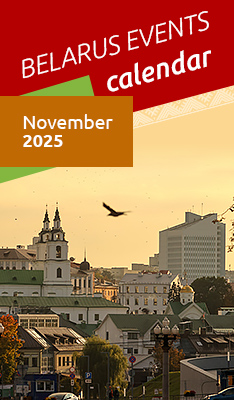
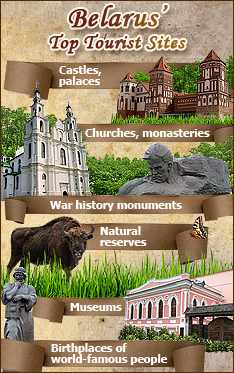



 print version
print version make home page
make home page add to bookmarks
add to bookmarks